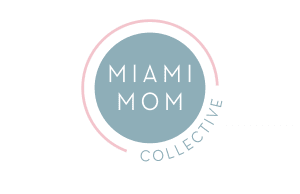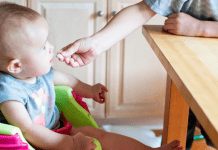This article is a unique collaboration between two Miami Mom Collective contributors. In this heartfelt post, Andrea Wood shares her journey of overcoming her fears of beginning solids with her daughter with feedback from Cindy Herde, a pediatric speech-language pathologist at Nicklaus Children’s Hospital.

Andrea 1/8/2021:
Recently, I’ve had the revelation that I spend more time dividing my daughter’s food into tiny little microscopic pieces than I actually do feeding it to her. My husband has nicknamed me the “food inspector.” When we all sit down for dinner with my daughter in the high chair, all food my husband places down on her tray is usually snatched up by me only to be meticulously further divided. She is about 13 months old, and most food she chews is about the size of a dime. Purees are still my best friend. They elude the comfort of safety to me. Deep down, I am aware I am holding her back due to my anxieties; she will choke, and I will lose control of the situation. When she gags or makes any distressed faces feeding, I go into a frenzy internally.
I have read many “feeding-based” blog posts only to be confused and sometimes amazed at some of the moms’ commitments to gourmet meals. I remember reading that lunch for a 1-year-old was salmon burgers and baked green beans, a meal that seemed more grandeur than anything I eat daily for lunch. The sense of “mom shame” washed over me. While I have begun to push myself a little bit out of my comfort zone, the food is now nickel-sized bites.
There are also about four different sippy cups I have ordered off Amazon in a frantic impulse buying spree due to my daughter using her sippy cup as a toy for the dog or a teether at all times. The world of sippy cups is confusing to me, with all sorts of different types of advice. Who knew a sippy cup would become such a source of stress to me!
Thankfully, I feel a sense of calm since Cindy Herde, a speech-language pathologist, offered to help me virtually. I was able to connect with Cindy through Miami Mom Collective. I feel less anxious knowing I am reaching out for help from a professional versus deciphering 10 different mommy blogs and getting five other friends’ opinions.
Cindy 1/10/2021: Pediatric Feeding Therapist
It is not unusual for parents to feel overwhelmed and anxious when offering their child those 1st bites of solids. It’s one of the most asked topics I get in the office and on social media. How big is too big of a piece? What to do when gagging? Can my child choke on crackers? Which sippy cup should I buy?
The market has too many options of utensils, plates, and cups, all claiming to be the best thing since sliced bread. Not to mention how saturated the internet and social media are, with everyone claiming their method is what you need for your child’s feeding journey. My 1st advice: stop the madness of Googling and quit relying on others without professional training. Although everyone’s help comes from a place of good intentions, it might not always be accurate. What works for one child might not work for yours. Simply because every child is different. Every household is unique. Not all mealtime dynamics are equal.
Let’s address a few topics addressed during our virtual consult:
Gagging and Choking
Although both scary, gagging and choking are different. It’s essential to know the difference and why these happen. Gagging is a reflex present in your child’s mouth, and with age, this reflex will continue to move further back. Around 6 months of age, the gag reflex is very much present in the mouth, and that can cause reactions with new foods.
Gagging is also meant as a self-defense mechanism to prevent choking. A baby or toddler will occasionally gag as he learns to eat various new foods, especially in the first years of life.
My advice: If your child gags remain calm, wait a few seconds, and see if the child can stay comfortable and continue eating. At times, a simple “chew chew’ prompt can help the child work through it. If you freak out, this only gets the child scared, making him doubt his own ability and potentially create fears around new foods.
Choking, on the other hand, is life-threatening. Choking happens when an object, in this case, food, gets stuck in the throat, partially or entirely blocking breathing. Signs your child might be choking are blueish skin color, difficulty breathing, inability to cry or make sounds, weak cough that is not effective, and soft or high-pitched sounds while inhaling for breath.
My advice: Make sure you can see your child at all times when eating. You don’t have to sit next to them, but you should be able to see their face at all times. Taking an infant CPR course is helpful to make parents feel more comfortable.
How big is too big?
The size you present foods to your new feeder will depend on the type of food and what your child likes. Foods like steamed carrots, cooked potatoes, and soft pears can be cut into little half-inch cubes or into long logs the size of an adult’s pinky. Small cubes help with the ‘pincer grasp,’ which is vital in developing fine motor skills. Long log-like shapes help with learning how to bite off pieces of food. Some baby/toddler food is ok to offer straight out of the container ( e.g., puffs, mum mums, etc.)
What about highchairs?
High chairs range in a variety of styles, sizes, and prices. An expensive chair does not equal functional. When it comes to sitting your child for mealtimes, I have two rules: position and support.

By providing proper support and positioning, it helps keep adequate breathing. It provides your child with stability so he/she can focus on eating. Trunk and hip support promotes better hand-to-mouth coordination as well as chewing.
Promote Independence
Children learn by doing, so by allowing your child to explore their food, you help them learn more about food through their senses (touch, smell, taste, etc.) This promotes independence in self-feeding. They might not master these skills right off the bat, but practice makes perfect. This will also teach children how much they need to bite off and handle chunks of food in their mouths. Be ok with mess when going through this phase.
What about sippy cups?
Sippy cups are most definitely not the best. When transitioning from the bottle or breast to a cup, you have plenty of options. Rule of thumb: the cup needs to encourage the child to use their lips, jaw, and tongue in ways that resemble how we typically drink. Sippy cups simply do not do that. Neither do the 360 drinking cups.
My advice: Instead, offer small open cups or straw bottles. My favorite straw bottle to start with is the Honey Bear straw bottle. Once your child gets the hang of it, you can transition to any other with a straw.

Andrea:
From my perspective, I was amazed when Cindy asked me to let my daughter try and eat a whole toddler granola bar on her own without breaking off any pieces. While I wanted to freak out internally, I was astonished at how my daughter handled the granola bar independently. This moment changed my entire perspective.
Andrea 1/18/21:
After about 10 days of trying to implement Cindy’s techniques, I noticed some significant improvements!
- Now that I understand some of the physiological aspects of feeding that Cindy explained, I no longer feel as anxious while my daughter is chewing.
- I am now giving my daughter larger food pieces and feel more comfortable pushing myself to do so.
- My daughter is now eating a greater variety of foods because I have less fear of certain ones.
- My daughter now sips from a straw independently. I tried a small cup, but she dumped it over right away. However, I know this new skill will come with time.
I still have my moments where I snatch the chicken off the tray in a moment of doubt, but I would say I am way more relaxed than before. My daughter also seems thrilled at all the new foods she gets to try.
Happy eating to you and your little ones!
Andrea Wood and Cindy Herde
















